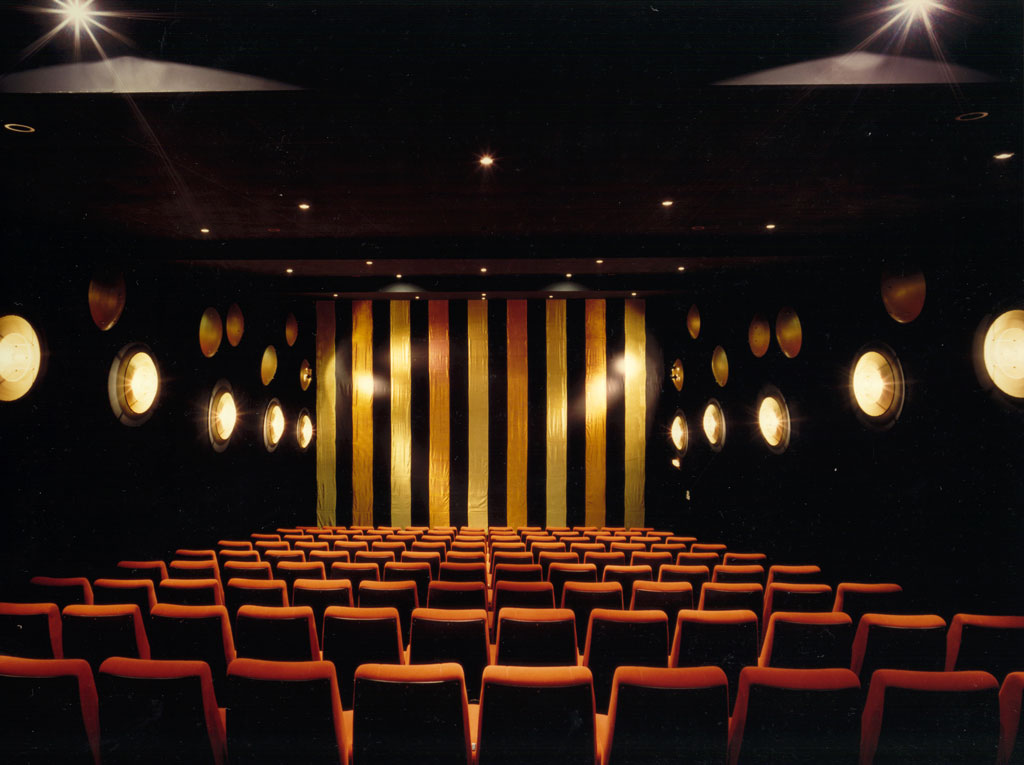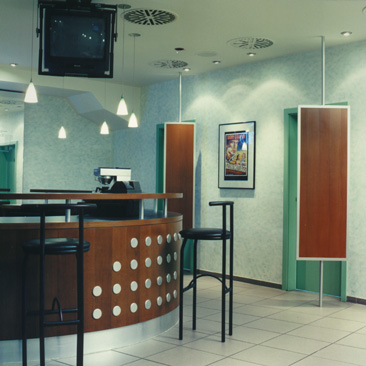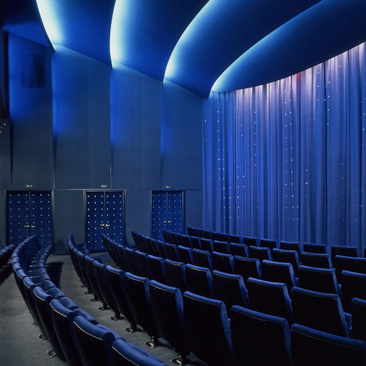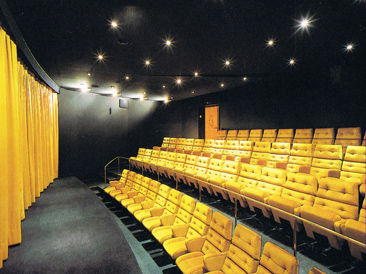Motion pictures as dream factory – a major challenge for lighting specialists – Part 3
 The golden, voulted bowls of perforated metal plate look like planets an stars floating in space; they furnish lighting for the main hall of the theatre, cover the loudspeaker, and serve as mounting fort he curtain lighting units
The golden, voulted bowls of perforated metal plate look like planets an stars floating in space; they furnish lighting for the main hall of the theatre, cover the loudspeaker, and serve as mounting fort he curtain lighting units
THE AMBO CINEMA, STUTTGART AND THE GABRIEL CINEMA, MUNICH
Shield and spear:
The Ambo cinema
The owners were looking for a clear concept with plenty of atmosphere. The planners decided on warm colours in gold, orange and sunshine yellow. The intention of the lighting design was to bathe the room, which was kept entirely black with the exception of the bright ornage Pullman seats, in a diffuse, soft light with the minimum of glare. For this reason the lamps were „condealed“ behind huge, gold-oxidised perforated metal dishes. It was even possible to use these dishes to cover the loudspeakers. Cinema-goers are made for feel as if they are sitting in outer space, floating between golden planets and stars. The heavenly bodies grow gradually dimmer as the film begins. Spatial restrictions meant that a gathered curtain had to be used in front of the screen. Eye-catching redish-gold and rich yellow stipes curtail the dynamism of the space-age decor. The film then appears from behind this slowly opening door like another world…
In addition to conventional recessed ceiling spotlights, the illuminated wall design plays a special role here: The circular lighting elements (70 cm diameter, golden anodized aluminum) were calculated by computer aided design. The resulting structure is as follows: incandescent lamp with clear bulb as illuminant, first primary reflector, first secondary reflector, second secondary reflector as large outer shell.
The dual layering of the two exterior reflectors ensures absolute non-glare.
The AMBO 4 was designed with oversized spears – almost as a counter-part to the golden round shields in Theatre 3. Dimmable room lighting was wall mounted behind them. The combination of matt silver stainless steel with the dark, burgundy/ violet seat covers and tableau curtain lends special elegance. The reference to ethnic shapes are intentional and quite unusual for a cinema.
Even from the street the flat coat of verdigrus used on the wall surfaces seems attractive and refreshing to passers-by. The light-coloured beech wood used in the bar counter and tables rises out of it surroundings, radiation warmth and friendliness. Mat silver surfaces and inlays set the style, underlining the easy-clean, robust design. The soft green spherical lamps above the counter echo the colour of the wallls. The overall design her eis light and bright before the cinema-goer enterst he theatre itself, where he will be gradually embraced by the warmth and darkness.
 Soft-green pendent luminaires and downlights endow the foyer with points of brilliance required for a glamorous entrée
Soft-green pendent luminaires and downlights endow the foyer with points of brilliance required for a glamorous entrée
 In the mirror behind the counter, the glow of light seem s to continue on into infinity, beyond the ceiling structure
In the mirror behind the counter, the glow of light seem s to continue on into infinity, beyond the ceiling structure
 The staggered glow of illumination from the ceiling bowls creates a spezial spatial impression here; this effect is reinforced by the backlit wall elements and their capability of being tipped to both sides
The staggered glow of illumination from the ceiling bowls creates a spezial spatial impression here; this effect is reinforced by the backlit wall elements and their capability of being tipped to both sides
 In the simply appointed, intimate Room 2 of the cinema, with only 63 seats, the effect of the lighting system on the golden-yellow upholstery of the chairs enhances the impression of comfort and prevents any feeling of apprehension from arising
In the simply appointed, intimate Room 2 of the cinema, with only 63 seats, the effect of the lighting system on the golden-yellow upholstery of the chairs enhances the impression of comfort and prevents any feeling of apprehension from arising
Munich’s oldest cinema:
THE GABRIEL CINEMA
During the conversion of the Gabriel Cinema lobby, one thing was clear: “The ceiling must stay.” The curved, drop structures combined with grooved Rabitz plastered surfaces and indirect lighting cannot really be re-created, and is beyond price these days. The same applied to the quarry stone floor, which enlivens the entrance area while being durable and easy to maintain.
Almost everything else was entirely revamped, though. Of course, as cost-efficiently as possible, but nevertheless with great impact. Munich’s oldest cinema opened its doors in 1906. Most recently it was used as a dimly lit porn cinema. With the conversion, and a new modern and welcoming atmosphere, this cinema was going to once again draw a broad audience.
Mint green, dusky pink and eggshell – typical 50s and 60s colours – as well as black and white play a central role in the design including the sweeping design of the ticket counter and high cocktail tables. They are intended to invoke hopeful feeling harking back to the “economic miracle”!
New neon fluorescent tubes with electronic ballast (EB) were used, which enormously improve efficiency, light quality and life, while highlighting the design. The selection of luminous colour was important, since the warm tone of the tubes softens the atmosphere and the transition to the light fixtures with incandescent light.
Rotating and swiveling ceiling down-lights arranged in an arc, ensure bright illumination of the counter area.
Theatre 1 with its impressively indirectly lit ceiling construction is located at lobby ground level. This fanned “disk effect” was reinforced with the tipped, and back-lit wall fixtures added to the sides. Additionally, the protruding elements hide away the speaker system.
Besides the colour scheme, which seems straight out of “The Arabian Nights”, in dark blue and silver, squares served as recurring design element: As sparkling, blinking appliqué on screen curtains or upholstered doors, as well as in the carpet decor and as face boards on the landing railing.
The indirect lighting of the theatre seating, making the intensive colours really glow, is a key element of the lighting design. Unfortunately, there were no low voltage down lights installed in the back area of Theatre 1. In contrast with conventional incandescent bulbs, these have the advantage of reduced consumption, while simultaneously offering more brilliant and also focused light over a longer life-span.
The motto was:“Just don’t use red, because it could be reminiscent of the recent use as porn cinema!” Therefore, the upper theatre now appears quite dignified in gold and black. In the past, this used to be the balcony of one large theatre, until in the mid 70s, it became a separate theatre when a sound and fire wall was installed.
The “G”’s tacked into the upholstered doors are in reference to Carl Gabriel, a “Directeur” of “Völkerschauen.” The cinema bears his name to this day.
Source: LICHT – 05/1997
Author: Anne Batisweiler
Publisher: Richard Pflaum Verlag GmbH & Co. KG
www.lichtnet.de






